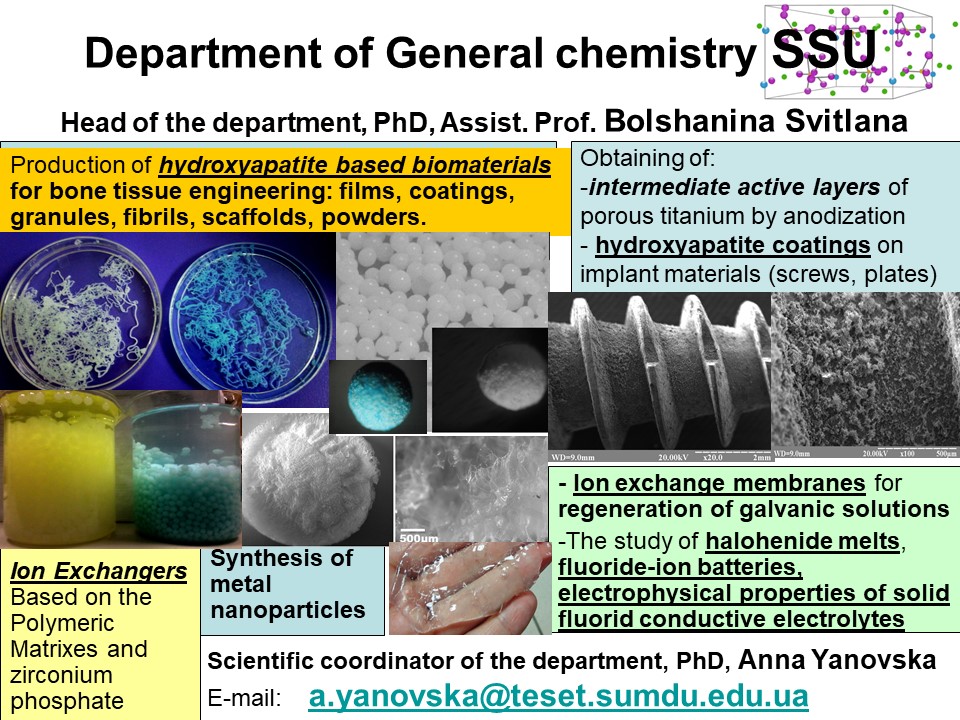- Details
- Written by Admin
- Category: It is interesting
- Hits: 585
Theoretical and Applied Chemistry Department have such Research activities:



- Details
- Written by Admin
- Category: It is interesting
- Hits: 1177
Chemical metallization
The Department of General Chemistry actively developed method associated with applying metallic coatings on various surfaces by using chemical processes. This method is based on the chemical metallization chemical "reactions silver mirror" and is applied to the surface of plastic, metal, aluminum, ceramics, metal mirror coatings that are highly reflective ability. Mirror metallized surface formed by chemical plating, characterized by a number of significant advantages.
First, such a method as chemical metallization practical from an economic point of view. It is not technically difficult and optimally fit into the processes. Set for chemical metallization easy to use, and coating similar to conventional spray paint application provides the ability to mirror coatings on metal products of any shape and size, from mobile phone cases to a large plaster statue. The resulting installation using chemical plating metallic mirror coating has a much lower cost compared to coatings derived galvanic way in baths or tanks.
Second, the metallization is universal. Brilliant metallic coating that has a high reflectivity can be applied chemically almost any surface, including the surface of a porous material including plastic, aluminum, ceramics, marble, plastic and so on. D.
Thirdly, the metallized surface obtained using the method as chemical plating, characterized by excellent mechanical properties, including high wear resistance and hardness. The final stage of the process here metallization is applied to the result obtained in the metallization reflective protective lacquer coating. In order to further improve the wear resistance and hardness over the lacquer coating in some cases, put a layer of ceramic or silicone varnish.
Fourth, the chemical metallization convenient that the dimensions of parts are practically unlimited. Unlike galvanic or vacuum metallization, where the size of the covered parts of limited size bath or the vacuum chamber, the chemical metallization details size does not matter.
Fifthly, such as chemical metallization process is completely harmless ecologically, it does not harm human health and the environment. Unlike many other types of chemical metallization metallization of plastic does not require the use of heavy metals.
When using the method of chemical metallization process technology is carried out in three stages. First details on the surface layer of special soil, active towards the subsequent metal layer. Then, using settings intended for chemical metallization of plastic on the soil surface covered with specially prepared chemicals sprayed that a chemical reaction to form on the surface of metal parts mirror coating. Finally, the resulting mirror coating layer of protective lacquer that protects the metallised surface of turbidity and mechanical wear. After curing and drying protective lacquer coating metallized looks exactly as if it was caused by electrolytic deposition. Adding a protective lacquer paint pigment toners, add exterior coating of chromium, aluminum, gold, copper, bronze and other metals and alloys.
 The evaluation adsorption capacity of clay rocks
The evaluation adsorption capacity of clay rocks
Clay rocks - the most common inorganic sorbents for the purification of sewage water.
To predict the adsorption properties of clays for their use in the purification of effluents proposed integrated method of estimating the composition of argillaceous rocks and study their adsorption properties under different conditions and environments.
In order to provide a comprehensive assessment of the quality of clay adsorbents used modern methods of physical and chemical analysis:
electron microscopy using scanning electron microscope "SEM-106-I" function of X-ray microanalysis;
X-ray analysis of samples for automated diffractometer DRON - 4.7;
chemical analysis using photocolorimeter CPK-2 MP and analytical equipment.
Advantages methods:
based on a comprehensive study of the structure and properties of argillaceous rocks predicted adsorption activity in a particular environment;
comprehensive analysis of clay allows to pick up necessary conditions for its activation to maximize the absorption of process.

